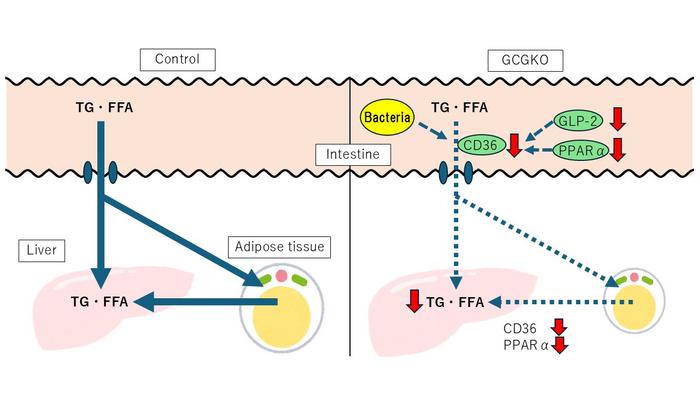A new study reveals how certain gut hormones play a crucial role in preventing diet-induced fatty liver disease, potentially opening doors to innovative treatments for this growing health concern.
Summary: Researchers discovered that a deficiency in proglucagon-derived peptides reduces lipid uptake in the intestinal tract, offering a promising new avenue for combating fatty liver disease.
Estimated reading time: 6 minutes
As obesity rates climb worldwide, so does the prevalence of fatty liver disease. This condition, characterized by excessive fat accumulation in the liver, poses significant risks for various metabolic disorders. While previous research has focused primarily on fat metabolism within the liver itself, a new study sheds light on the critical role of the gut in this complex process.
Led by Associate Professor Yusuke Seino from Fujita Health University, the research team explored how proglucagon-derived peptides (PGDPs) impact fat absorption and liver fat buildup. Their findings, published in Nutrients on July 14, 2024, suggest a novel approach to preventing fatty liver disease.
The Gut-Liver Connection
The study used genetically modified mice lacking PGDPs, known as GCGKO mice, to investigate the response to a high-fat diet (HFD) over seven days. The results were striking.
“When we subjected both GCGKO mice and control mice to an HFD for one week, the GCGKO mice exhibited a significantly lower increase in hepatic free fatty acid (FFA) and triglyceride levels, along with reduced adipose tissue weight,” Dr. Seino explained.
This effect was attributed to a decrease in lipid absorption via the CD36 pathway in the intestinal tract, despite a reduced fat-burning capacity (β-oxidation) in the liver.
Unraveling the Mechanism
The research team found lower expression levels of genes involved in FFA oxidation in HFD-fed GCGKO mice. Particularly, Pparα (peroxisome proliferator receptor alpha) and Cd36 (cluster of differentiation 36) mRNA levels were reduced in the duodenum, correlating with a decrease in fat uptake in the intestines and increased fecal cholesterol content.
These findings suggest that the absence of PGDPs prevents diet-induced fatty liver by lowering intestinal fat absorption. This was further confirmed by lower plasma triglyceride levels during an oral fat tolerance test (OFTT) in HFD-fed GCGKO mice.
Implications for Gut Health and Metabolic Function
The study also uncovered intriguing connections between diet, hormonal responses, and intestinal microbiota. HFD-fed GCGKO mice demonstrated notable shifts in gut bacteria, with an increase in Parabacteroides and a decrease in Lactobacillus, both linked to obesity resistance.
Dr. Seino noted, “If we can examine in more detail how PGDPs specifically regulate lipid absorption in the gut, we hope to clarify the relationship between diet, hormones, and intestinal bacteria sufficiently to recommend a diet that is less conducive to obesity and fatty liver disease.”
Future Therapeutic Potential
The research opens up exciting possibilities for new therapies targeting fatty liver disease. Dr. Seino speculated on the long-term implications: “In the future, oral dual antagonists of GLP-2 and glucagon could emerge as potential therapies for obesity and fatty liver, especially given their roles in insulin sensitivity and lipid metabolism.”
While the findings are promising, it’s important to note that this research is still in its early stages. Translating these results from mice to humans will require further study and clinical trials.
Questions and Considerations
As with any groundbreaking research, this study raises several questions:
- How would these findings translate to human physiology?
- What potential side effects might arise from manipulating gut hormone levels?
- Could dietary interventions alone achieve similar results without pharmaceutical intervention?
These are areas that future research will need to address as scientists work to develop targeted therapies for fatty liver disease.
Quiz: Test Your Knowledge
- What type of mice did the researchers use in their study?
- Which pathway in the intestinal tract showed decreased lipid absorption in the study?
- What potential future therapy did Dr. Seino suggest based on the study’s findings?
Answers:
- GCGKO mice (mice lacking proglucagon-derived peptides)
- The CD36 pathway
- Oral dual antagonists of GLP-2 and glucagon
Further Reading
Glossary of Terms
- Proglucagon-derived peptides (PGDPs): Hormones derived from proglucagon, including glucagon, GLP-1, and GLP-2.
- Fatty liver disease: A condition characterized by excessive fat accumulation in the liver.
- CD36 pathway: A molecular pathway involved in cellular uptake of fatty acids.
- β-oxidation: The process by which fatty acids are broken down in the body to produce energy.
- Microbiome: The collection of microorganisms living in the human body, particularly in the gut.
- Lipid metabolism: The processes by which lipids (fats) are synthesized, broken down, and utilized in the body.
Enjoy this story? Get our newsletter! https://scienceblog.substack.com/


